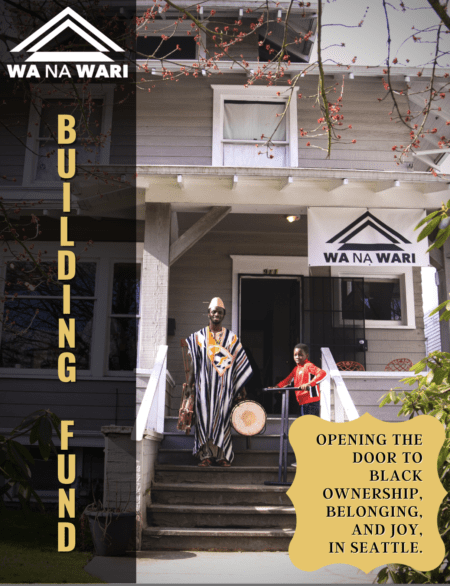
Welcome to the fifth part of the Technology Matching Fund & Digital Navigator Cohort Grant blog series! In this series, Seattle IT will be covering the Technology Matching Fund and Digital Network Cohort which is a project to build onto Seattle’s Digital Equity Statement and how qualifying non-profits can apply.
Generally, there is a stereotype that art and technology are opposites. However, those at Wa Na Wari have managed to incorporate modern technology into artistic expressions. Wa Na Wari serves as a center for art and belonging for the Black community in Seattle. In Seattle IT’s interview with Jill Freidberg, one of Wa Na Wari’s Co-Founders and Assistant Culture Keeper, Freidberg states that “We use technology for art all the time.”
In Wa Na Wari’s case, Freidberg explains with the Technology Matching Fund grant, Wa Na Wari was able to purchase audio spotlight speakers usually found in museums and art galleries. The audio spotlight speaker casts a direct cone of sound that you would not hear outside of the cone. Wa Na Wari used this to share oral histories with the public recorded by the Black Spatial Histories Institute. Freidberg elaborates that, “It’s using like really old technology like storytelling, but the technology that we’re using to share those stories with the public is really new and technologically advanced.”
Wa Na Wari has two projects that are being served by the Technology Matching Fund grant. One of which was mentioned previously, the Seattle Black Spatial Histories Institute. The Seattle Black Spatial Histories Institute was a program that trained black community members in community based on oral history. The grant allowed Wa Na Wari to purchase recording equipment and software subscriptions that made the interview processes efficient and convenient. Which Freidberg voices is important because, “There’s a lot of narratives of erasure that kind of have accompanied the gentrification of the Central District and the displacement of the historic black community in the Central District. Countering those narratives of erasure means recording the stories and histories of the people that shaped that neighborhood and building black futures requires complex understanding of black pasts.”
The second project is the Central Area Cultural Ecosystem for the 21st Century Initiative (CASE 21) which is still ongoing. CASE 21 is a community research and homeowner organizing project where community members are trained to do qualitative and quantitative research with black homeowners and artists to understand the challenges facing black homeowners and artists. Wa Na Wari takes the project a step further, planning to work with black homeowners to organize for shifts in municipal and county policy to make it easier for black homeowners to use their properties for arts and culture activation. Because the process is rife with obstacles and is complex, Wa Na Wari uses the Technology Matching Fund here “to purchase equipment as well as training on research and data visualization software so that the surveyors could learn how to make sense of the data that they’re gathering from the homeowners that they’re serving.”
Freidberg says that “The participants have shared how important it has been for them to participate and build these skills and how excited they are about continuing the work. Beyond the Institute they want to keep doing this work.” Given the recipients both have the stories and technical skills supplied by the Technology Matching Fund, they are excited to continuing the work, recording more stories and sharing them with the public. With hope that there will be a next cohort that is trained by the graduating cohort and will continue with a line of successors.
When asked if she had any advice for people applying for the Technology Matching Fund, Freidberg advises, “The advice I would offer for people applying is to stay organized.” There is hefty paperwork to go through when applying for the Technology Matching Fund she explains. However, Freidberg also states that the Technology Matching Fund should not only be thought of as an opportunity to buy technology. Instead, it should be thought of as a way to build capacity around the use of technology.
If you did not catch the last part of the Technology Matching Fund and Digital Navigator blog series, you can read about it here:
Stay tuned for the next part of this blog series where additional past winners will be covered.
You can learn more about Digital Equity grants by following this link: